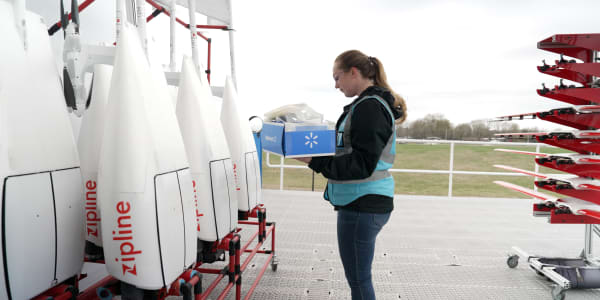Housed inside the 27-story WeWork (2016 CNBC Disruptor No. 34) building at 110 Wall Street in lower Manhattan is the latest iteration of the company's take on the "we" way of life: WeLive. Opened for about six months, the residential apartments pick up where WeWork leaves off, quite literally.
On floors 2 through 6 of the building are WeWork shared office spaces. Right above, on floors 7 through 18, you'll find the WeLive apartments (floors 19 through 27 are scheduled to be complete by Aug. 1).
A second WeWork/WeLive mixed-use building is located in Crystal City, Virginia, with the 260 residential units having opened May 1. Though WeWork claims to be testing its co-living concept with these two inaugural buildings, the company is hardly standing still. Deals for new locations in New York City, London, San Francisco and Los Angeles are reportedly already being negotiated.
In fact, WeWork co-founder and chief creative officer Miguel McKelvey says the market for its shared-living residences is potentially bigger than that for its co-working spaces, which currently number 75 locations in 22 cities around the world and 55,000 members.
The WeLive apartments in New York City range from studios to four-bedroom units that can accommodate up to eight people. A private bedroom in a shared apartment starts at about $1,700 a month; a private studio runs around $2,700 a month. The rents aren't super-cheap — nor does the company promote them that way — but they typically cost less than other buildings in the neighborhood.
The company charges residents a $125 monthly fee that covers cable, internet, fitness classes in a large all-purpose space that also doubles as a screening room, and a monthly cleaning service. All apartments have private kitchens and at least one bathroom and come furnished. Included as well: sheets, towels, dishes and even bathroom toiletries. They can be rented for as long or as short as needed.
Though they've only been on the market for a short time, some critics have already dubbed WeLive apartments simply "dorms for millennials." The atmosphere certainly does conjure up a certain college vibe.
On the day we interviewed co-founder McKelvey at 110 Wall Street, we sat at a giant farm table in the spacious and well-appointed communal kitchen on the seventh floor. Residents shuffled in and out — some grabbing free coffee and juice, some lounging around on their phones or watching movies on their laptops. Other common areas in the building include a huge laundry room tricked out with video games and a pool table.
A community manager (not unlike a college RA) helps to organize Sunday night dinners, game nights and karaoke — all designed to bring residents together and promote the belief that gathering and sharing is a better way to co-exist with your neighbors.
And therein lies the secret ingredient for WeWork. It's not that shared office space or co-living arrangements are original ideas. Publicly traded Regus has been leasing out individual tech-powered offices for more than two decades and is currently operating 2,300 business centers across 120 countries. And similar co-living start-ups, such as Common in Brooklyn, and Roam, with locations all over the world, have been around a bit longer than WeLive.
What parent company WeWork does is take these basic concepts and repackage them with the community element baked right in. You don't just live in a WeLive apartment; you share, interact, collaborate and commiserate with your fellow residents.
A living community
McKelvey, 41, a tall, bearded man who grew up in a collective in Oregon with his mom and four other families, claims the idea for WeLive was actually present from the company's earliest days. "When Adam [Neumann, WeWork's other founder] and I started WeWork in 2010, the 'we' part of the equation was the most important thing to us," he says. "We just found it easier to start with office space. But the idea of doing something together, of being in something together with other people, is really, really powerful."
Or really annoying, depending on your point of view. There are those who have no interest in sharing office space with strangers or bumping up against neighbors in a community kitchen first thing in the morning. But for plenty of other folks — mainly those in their 20s and 30s — the camaraderie and give-and-take that comes from being around other people who are trying to start (or restart) their lives and careers can be a welcome offering.
In fact, according to Anita Shannon, the 23-year-old community manager at 110 Wall Street, the apartments that are open are fully leased, and the units opening in August are nearly all taken. What these folks are willing to give up in privacy they get back in the form of a ready-made social network.
Just listen to John Shi, a 26-year-old Dartmouth graduate who started a sports apparel company called Hillflint two years ago. In June he moved his three-person start-up from his hometown of San Francisco to New York City and leased a four-desk WeWork office suite on the fourth floor of 110 Wall Street. A few weeks later he moved into a WeLive studio apartment a few floors above.
"I like the camraderie and the fact that there are other people to talk to in the kitchen or laundry room," he says. "New York can be kind of isolating because everyone works really hard and long hours, but here you're around other people going through the same thing."
As for the criticism that the apartments are nothing more than grown-up dorms, Shi says, "people have jobs and professional goals here. That's not what you find in a dorm."
If you can figure out a way for people at all different stages of life to believe that they're all meaningful to each other, then yes, WeLive can work anywhere.Miguel McKelveyco-founder of WeWork
As the next step in the company's "we" franchise, WeLive can naturally tap into the same big-name developers that partner with WeWork. For instance, the 110 Wall Street location is owned by Rudin Management, the prestigious century-old real estate development firm. The office building had been around since the early 1960s but was badly damaged during Hurricane Sandy in 2012. CEO William Rudin says his company briefly considered tearing it down. But a few weeks after the storm, he met there with WeWork co-founder Adam Neumann.
"We're walking through the building with flashlights because all the power was still out, and Neumann says, 'I have an idea,'" Rudin recalls. Three days later he proposed the first mixed-use WeWork/WeLive concept and the building's redesign was under way. Rudin Management supplied the money — a reported $60 million — to "Sandy-proof" the building by moving all the essential mechanical and electrical components from the basement to the 12th floor and to do the build-out of the new WeLive residential space. Rudin still owns the building, with WeLive taking a 30-year lease.
"There was a big question about whether downtown Manhattan was ever going to bounce back after Sandy," Rudin says. "But we decided to go ahead with the renovation in part because of Adam's and Miguel's vision and their sense of community. This deal has already paid dividends for us."
Making connections
Though WeLive is in its earliest stage, McKelvey says the company can easily see a time when WeLive buildings include features and amenities that cater to demographics beyond millennials, such as families with young children and older adults.
He also believes that the addressable market — people looking for living space in urban areas — is bigger than the market for office space. In fact, in documents prepared for investors not long ago, the company projects that revenue from WeLive apartments would ramp up to nearly a quarter of the company's total within the next two years.
"Look, I'm 41 with a six-year-old son," McKelvey says, "and even though I live in a building with a million kids, he doesn't have one friend there because there's no context for making that happen. I think there's a huge market for a connected building where I could broadcast to other parents that I want to set up a playdate for my child."
McKelvey believes the same dynamic exists at the other end of the spectrum, where older folks would welcome a chance to live among, and interact with, young families or those in their 30s and 40s.
Says he: "If you can figure out a way for people at all different stages of life to believe that they're all meaningful to each other, then yes, WeLive can work anywhere."
— By Susan Caminiti, special to CNBC.com







